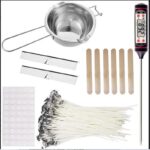Candle making has been around for centuries, and with the growing popularity of handmade products, it has become a thriving business for many entrepreneurs. In this article, we will explore the potential profitability of candle making as a business venture.
From the history of candle making to the costs and investment required, pricing and profit margins, marketing strategies, success stories, and tips for maximizing profits, we will delve into every aspect of this art form to answer the question: Can candle making be profitable?
The art of candle making dates back to ancient times when candles were primarily made from animal fats or beeswax. Over the years, the process has evolved significantly, giving rise to a wide variety of candles made from different materials and in various shapes, sizes, and scents.
As consumer preferences shift towards handmade and artisanal products, the demand for unique and high-quality candles continues to rise. This trend presents a lucrative opportunity for individuals looking to turn their passion for candle making into a profitable business endeavor. However, like any business venture, there are certain factors that must be considered in order to succeed in this competitive market.
History of Candle Making and Its Evolution
Candle making is an ancient art that has evolved over thousands of years. The earliest known candles were made from whale fat by the Chinese during the Qin Dynasty (221-206 BCE). These candles were used for illumination and religious ceremonies. Throughout history, different civilizations have developed their own unique methods and materials for creating candles, including beeswax, tallow, and paraffin wax.
The evolution of candle making took a significant turn with the invention of the first mass-produced candle in 1834 by Joseph Morgan. This innovation paved the way for the widespread availability of affordable candles, leading to their use in homes for lighting and decorative purposes. In recent years, there has been a resurgence of interest in handmade candles as people seek out sustainable and artisanal alternatives to mass-produced products.
Today, candle making has become a popular craft and hobby for many individuals. With the rise of social media and e-commerce platforms, independent candle makers can easily reach a global audience. The demand for unique and high-quality handmade candles has created a niche market that caters to consumers looking for personalized and environmentally friendly home decor items. As a result, candle making has become not only an enjoyable pastime but also a potentially profitable business venture.
The Growing Popularity of Handmade Candles
In recent years, there has been a noticeable shift in consumer preferences towards handmade products, including candles. The growing popularity of handmade candles can be attributed to several factors, including the increasing interest in sustainability and natural products, as well as the desire for unique and personalized items. Handmade candles offer consumers a more artisanal and high-quality alternative to mass-produced ones, making them an attractive choice for those seeking a special touch in their homes or as gifts.
Handmade candles offer numerous benefits compared to commercially manufactured ones. They are often made with natural and sustainable materials, such as soy wax and essential oils, making them more environmentally friendly and healthier for both the consumer and the environment.
Additionally, handmade candles come in a wide variety of unique scents, colors, and designs that cannot be found in standard store-bought options. This level of customization appeals to consumers looking for something one-of-a-kind that adds a special touch to their living spaces.
Challenges of Meeting Growing Demand
Can Increase
their profitability even in a competitive landscape.
The Potential Market for Handmade Candles
Handmade candles have experienced a surge in popularity in recent years, as more and more consumers seek out unique and artisanal products. This has created a growing market for homemade candles, with many people eager to purchase high-quality, personalized candles for their homes or as gifts for loved ones.
The potential market for handmade candles is diverse and includes a wide range of demographics, from young adults looking to decorate their living spaces to older individuals seeking natural and chemical-free products.
One of the main selling points of handmade candles is the ability to customize them according to customers’ preferences. This can include choosing specific scents, colors, sizes, and even personalized designs or messages.
As a result, the potential market for handmade candles extends beyond individual consumers to include businesses looking for unique corporate gifts or event favors. Additionally, the demand for eco-friendly and sustainable products has also contributed to the increasing market for handmade candles, as individuals seek out alternatives to mass-produced and synthetic options.
The potential market for handmade candles also extends beyond traditional retail channels, with opportunities to sell through online platforms such as Etsy, social media channels like Instagram, or at local craft fairs and markets. Furthermore, with the rising interest in wellness and self-care practices, there is also a growing niche market for aromatherapy and therapeutic candles that cater to individuals seeking relaxation and stress relief.
In conclusion, the potential market for handmade candles is vast and continues to grow as consumer preferences shift towards unique and ethically crafted products.
- Handmade candle enthusiasts
- Eco-conscious consumers
- Businesses seeking unique gifts
- Aromatherapy enthusiasts
- Individuals looking for personalized home decor
Costs and Initial Investment for Candle Making
Candle making is a popular and profitable craft that many individuals engage in as a hobby or even as a full-time business. However, like any business venture, there are costs and initial investments involved in starting a candle making business. From sourcing materials to investing in equipment, it’s important to carefully consider the financial aspects before diving into the world of candle making.
Costs of Materials
One of the primary costs associated with candle making is the materials needed to create the candles. This includes wax, wicks, fragrance oils, dyes, and containers. The cost of these materials can vary depending on the quality and quantity purchased. For example, natural soy or beeswax may be more expensive than paraffin wax, but they appeal to a specific market segment seeking eco-friendly options.
Equipment and Tools
In addition to materials, candle makers also need to invest in equipment and tools for their craft. This can include melting pots, thermometers, pouring pitchers, molds, and other accessories. While some items may be reusable for multiple batches of candles, others will need ongoing replacements or upgrades. The initial investment in equipment will depend on the scale at which you plan to operate your candle making business.
Business Permits and Insurance
Beyond the actual production costs, candle makers should also consider expenses related to permits and insurance. Depending on local regulations, there may be costs associated with obtaining necessary permits or licenses for operating a small business from home or from a dedicated space. Additionally, it’s important to protect your business with liability insurance in case of accidents or other unforeseen events related to your products.
Ultimately, understanding the costs and initial investment required for candle making is crucial when evaluating whether this can indeed be a profitable venture. By carefully weighing these financial considerations against potential revenue streams and profit margins, aspiring candle makers can make informed decisions about pursuing this business opportunity.
Pricing and Profit Margins in the Candle Making Business
Setting the right prices for your handmade candles is crucial to the profitability of your candle making business. When determining the price for your candles, it’s important to take into account the cost of materials, labor, packaging, overhead expenses, and desired profit margin. Calculating all these costs will help you set a competitive yet profitable price for your products.
One way to ensure a healthy profit margin is by carefully sourcing your materials and supplies. Buying in bulk or finding wholesale suppliers can significantly reduce your production costs, allowing you to increase your profit margins. Additionally, developing a range of candle products at varying price points can help attract different customer segments while maximizing overall sales.
Marketing also plays a key role in determining the perceived value and, therefore, the pricing of your handmade candles. Higher-end branding and packaging can justify higher prices for your products, while also serving as a competitive advantage in a crowded market. By creating a unique selling proposition and effectively conveying it to potential customers, you can command higher prices for your handmade candles.
Finally, regularly reviewing and adjusting your pricing strategy based on market demand, competition, and production costs can position your candle making business for long-term profitability.
| Factors | Considerations |
|---|---|
| Costs | Materials, labor, overhead expenses |
| Sourcing | Wholesale suppliers or bulk purchasing |
| Marketing | Branding, packaging, unique selling proposition |
Marketing and Selling Handmade Candles
When it comes to marketing and selling handmade candles, there are several strategies that can be employed to reach a wider customer base and increase sales. One effective approach is to utilize social media platforms such as Instagram, Facebook, and Pinterest to showcase your unique candle designs and engage with potential customers.
By creating visually appealing content and sharing behind-the-scenes glimpses of the candle making process, you can build a loyal following and drive traffic to your online store or physical retail location.
In addition to social media, participating in local craft fairs, farmers’ markets, and artisanal pop-up events can provide valuable opportunities to connect with customers face-to-face. These events allow customers to see and smell your candles in person, which can greatly enhance their purchasing decision. Building partnerships with other local businesses, such as spas, gift shops, or boutique stores, can also help expand your reach and get your candles onto more shelves.
Furthermore, investing in professional packaging and branding for your handmade candles can make a significant impact on sales. Eye-catching labels, custom logo design, and high-quality packaging materials can elevate the perceived value of your products and make them stand out in a crowded market. Creating an online presence through e-commerce platforms like Etsy or Shopify can also open up new avenues for selling your candles beyond your local area.
Lastly, offering special promotions, discounts for repeat customers, or limited edition candle collections can generate excitement and encourage repeat business. Building a strong brand identity through consistent messaging and customer interaction is key to developing a loyal customer base that will keep coming back for more. By implementing these marketing and selling strategies effectively, you can increase the profitability of your candle making business.
| Marketing Strategy | Impact |
|---|---|
| Social Media Engagement | Builds a loyal following |
| Participating in Local Events | Connects with customers face-to-face |
| Professional Packaging | Elevates perceived value of products |
Success Stories and Case Studies of Profitable Candle Making Businesses
Candle making has been a popular craft for centuries, but in recent years, it has evolved into a profitable business for many entrepreneurs. There are numerous success stories and case studies of individuals who have turned their love for candle making into a lucrative venture. These businesses provide valuable insight into the potential profitability of candle making and can serve as inspiration for those looking to enter the industry.
One such success story is that of a small-town candle maker who started creating unique, hand-poured candles in her home kitchen. Through word-of-mouth and social media marketing, her business quickly gained traction, and she was able to expand into selling her products at local farmers’ markets and boutique shops. With careful attention to quality and customer service, she was able to cultivate a loyal customer base and ultimately turn her passion into a profitable enterprise.
Another case study involves a couple who decided to start a candle-making business as a side project. As demand for their products grew, they found themselves devoting more time and resources to the endeavor.
Eventually, they made the decision to leave their full-time jobs to focus on their candle business, which has since become their main source of income. Their experience showcases how dedication and perseverance in the face of challenges
These success stories demonstrate that with the right combination of creativity, determination, and strategic marketing, candle making
Tips and Strategies for Maximizing Profit in Candle Making
For those wondering if candle making can be profitable, the answer is a resounding yes. However, in order to maximize profit in this business, there are several tips and strategies that aspiring candle makers should consider.
One important tip for maximizing profit in candle making is to source materials at the best possible prices. Buying in bulk from wholesale suppliers can significantly reduce costs and increase profit margins. Additionally, exploring different options for packaging and presentation can also help lower expenses while adding value to the product.
Another strategy for maximizing profit in candle making is to diversify product offerings. By creating a variety of scents, sizes, and styles of candles, candle makers can appeal to a wider range of customers and increase sales. Offering customization options such as personalized labels or custom scent blends can also attract more customers willing to pay a premium price for unique products.
Finally, effective marketing and branding can play a crucial role in increasing profits in the candle making business. Creating an attractive online presence through social media and e-commerce platforms can help reach a larger audience and drive sales. Additionally, building relationships with local retailers or artisans markets can provide additional avenues for selling handmade candles at a higher price point.
Conclusion
In conclusion, the art of candle making has a long history and has evolved into a popular and profitable business in today’s market. Handmade candles have seen a surge in popularity as consumers appreciate the unique and personalized touch they bring to their homes. This growing demand for handmade candles opens up a potential market for aspiring entrepreneurs who are considering entering the candle making industry.
While there are initial costs and investments involved in setting up a candle making business, the potential for profit is significant. By pricing the products competitively and maximizing profit margins, candle makers can certainly turn their passion into a profitable venture. With effective marketing strategies and selling techniques, reaching out to potential customers can also drive sales and boost profitability.
Many success stories and case studies have shown just how profitable candle making businesses can be. With careful planning, innovative ideas, and dedication, individuals have turned their love for candle making into thriving enterprises.
Aspiring candle makers should not only be encouraged by these success stories but also take away valuable tips and strategies for maximizing profit in this industry. Overall, with the right approach, creativity, and business acumen, candle making can indeed be a profitable business venture for those who are passionate about this craft.
Frequently Asked Questions
Is Candle Making a Good Business Idea?
Candle making can be a good business idea for those who are passionate about creating unique and high-quality products. With the growing demand for natural and artisanal goods, there is a market for handcrafted candles. However, like any business, it also requires careful planning, creativity, and a solid understanding of the industry to succeed.
Is It Hard to Have a Successful Candle Business?
Like any business, running a successful candle business comes with its own set of challenges. It can be competitive, and it takes time and effort to establish a brand and customer base. Success in the candle business often depends on factors such as product quality, marketing strategies, and understanding consumer preferences.
What Kind of Candles Sell the Most?
Different types of candles sell well depending on the market trends and consumer preferences. Currently, scented candles are popular due to their ability to create ambiance and offer aromatherapy benefits. Additionally, natural or organic candles made from soy or beeswax are also in high demand due to their eco-friendliness.
Seasonal and holiday-themed candles also tend to sell well during specific times of the year. Understanding market trends and consumer preferences is key to determining which types of candles will sell the most.

Welcome to my candle making blog! In this blog, I will be sharing my tips and tricks for making candles. I will also be sharing some of my favorite recipes.





